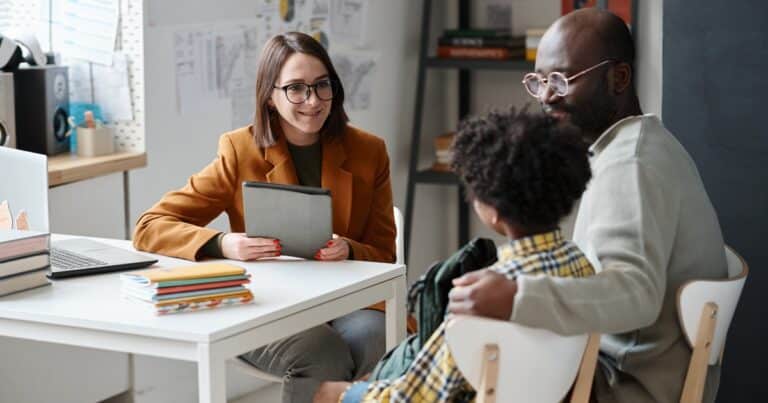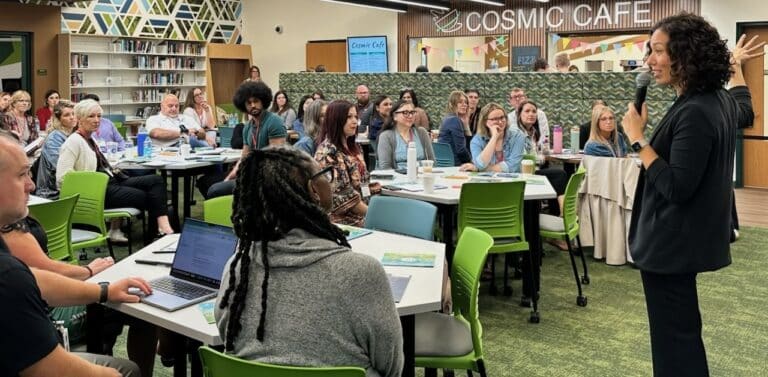When describing personalized, competency-based education, the concept is well-received by most – students moving through experiences based on mastery of skill rather than seat time, lessons customized to accommodate individual needs and students taking ownership of their own learning. What’s not to like?
Educators and administrative leaders on the other hand are understandably skeptical of how it will work and are full of questions about its practicality.
I have 30 kids in my class. Do I create a different lesson plan for each of them?
No. A learner-centered classroom doesn’t mean the teacher creates individual lesson plans for each learner. Instead, students and teacher work together to determine learning targets and how a learner can show evidence of mastery. For instance, a teacher may create a playlist or choice board with five potential activities aligned to a given learning target. Students are then asked to make meaningful choices about how they’ll practice a particular skill and demonstrate their learning based on the options presented.
How do you get the kids to ‘own’ their learning?
Student agency begins with shared vision and standard operating procedures. For instance, a teacher may create guidelines for collaborative work groups. These procedures should be designed in concert with the students and lay the groundwork for student agency by providing clear expectations for students regarding their roles and responsibilities; processes for goal setting and decision making; and establishing mechanisms for individual accountability within a group.
How do I manage various learning levels?
In the beginning, teachers maintain more control of the flow and format. As teachers develop their classroom practices and personalized-learning culture, this format becomes more learner-driven. As students demonstrate readiness, more voice and choice can be provided. Voice and choice can be incorporated into the classroom in a variety of ways regardless of levels.
- Topic Selection: Allow students to choose topics or themes for projects or assignments within a given scope or subject area.
- Project Formats: Offer multiple options for project formats, such as written essays, multimedia presentations or creative visual displays. Students can choose the format that aligns with their strengths and interests.
- Learning Pathways: Provide students with a variety of resources, materials and activities catering to different learning styles and then allow students to choose the pathway that best suits their learning needs, whether it’s reading text, watching a video or engaging in hands-on experiments.
- Assessment Options: Offer alternative assessment methods that provide students with a choice for demonstrating their understanding of concepts. This might include presentations, portfolios or self-assessments.
- Learning Environment: Provide flexible seating arrangements, quiet zones and collaborative spaces within the classroom. Students can choose the environment that supports their preferred learning style or the task at hand.
- Pace and Timing: Allow students to work at their own pace within reasonable deadlines. This gives students the freedom to allocate their time based on their individual needs and learning process.
- Personal Learning Projects: Allocate time for students to pursue self-directed projects or inquiries aligned with their interests and goals.
- Reflection and Feedback: Provide opportunities for students to reflect on their learning experiences and provide input on instructional methods, resources and classroom activities.
By incorporating voice and choice into the personalized learning classroom, educators further empower students to take ownership of their learning by tapping into their intrinsic motivation while developing essential skills such as decision-making, self-advocacy and personal responsibility. Individual activities are complemented with teacher-facilitated small group work.
How does working with students at different learning levels impact group instruction?
While whole group instruction is still an instructional strategy that can be used, much of the instruction will occur within the flexible groupings of kids in a workshop-style instructional model.
Transitioning to this type of system is a process and developing the right classroom culture and transparency to support student agency takes time. KnowledgeWorks helps school districts navigate these challenges and partners with teachers to effectively support individual student needs.

Vision-Led, Learner-Driven
An introduction to a personalized, competency-based learning transformation journey shows why it’s needed, major components of personalized, competency-based learning and what next steps can look like





